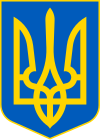Tamga
A tamga or tamgha (from Old Turkic: 𐱃𐰢𐰍𐰀, romanized: tamga, lit. 'stamp, seal'; Turkish: damga; Mongolian: tamga; Adyghe: тамыгъэ, romanized: tamığə; Kabardian: дамыгъэ, romanized: damığə) was an abstract seal or stamp used by Eurasian nomads and by cultures influenced by them. The tamga was normally the emblem of a particular tribe, clan or family. They were common among the Eurasian nomads throughout Classical Antiquity and the Middle Ages. As clan and family identifiers, the collection and systematic comparison of tamgas is regarded to provide insights into relations between families, individuals and ethnic groups in the steppe territory.[1][2]
Similar tamga-like symbols were sometimes adopted by sedentary peoples adjacent to the Pontic–Caspian steppe both in Eastern Europe and Central Asia.[3][4][5][6]
It has been speculated that Turkic tamgas represent one of the sources of the Old Turkic script of the 6th-10th c.,[7] but since the mid-20th c., this hypothesis is widely rejected as being unverifiable.[8]
Tamgas originate in pre-historic times, but their exact usage and development cannot be continuously traced over time. There are, however, symbols represented in rock art that are referred to as tamgas or tamga-like.[9] If they serve to record the presence of individuals at a particular place, they may be functionally equivalent with medieval tamgas.
In the later phases of the Bosporan Kingdom, the ruling dynasty applied personal tamgas, composed of a fragment representing the family and a fragment representing the individual king, apparently in continuation of steppe traditions and in an attempt to consolidate seditary and nomadic factions within the kingdom.[10]
According to Clauson (1972, p.504f.), Common Turkic tamga means "originally a `brand' or mark of ownership placed on horses, cattle, and other livestock; it became at a very early date something like a European coat of arms or crest, and as such appears at the head of several Türkü and many O[ld] Kir[giz] funary monuments".[11]




.jpg/440px-Tarih-i-al-i-selcuk-1_(1).jpg)

